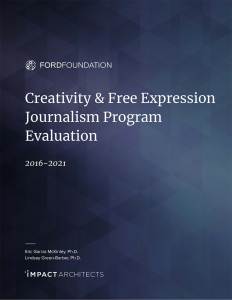Evaluation of Ford’s Creativity and Free Expression Journalism Strategy
The Challenge
Since its launch in 2015, the Ford Foundation’s Creativity and Free Expression (CFE) program has worked collaboratively to invest in creative organizations and storytellers shaping a more inclusive, just world across three areas of focus: Arts and Culture, Journalism, and documentary filmmaking through its JustFilms initiative. To assess impact and alignment with the changing needs of the field, the foundation is conducting a series of evaluations around each area of focus under the CFE program. This evaluation report on the CFE journalism strategy, distributed by Impact Architects, is one in a series of three evaluations to explore how arts and creative sectors can address inequality and advance justice.
The Creativity and Free Expression journalism strategy is situated in a context wherein some communities have historically been ignored by the mainstream media, including: women, people of color, people with disabilities, LGBTQ+ communities, and underserved rural communities. In addition, the news outlets that serve those communities have largely not had access to philanthropic support or resources. A foundational element of this context is evident in the 1968 Kerner Commission report, which identified an array of “separate and unequal” social services available to U.S. residents as a core reason for the urban uprisings of the late 1960s. Among the report’s recommendations regarding journalism were the need to expand coverage of Black communities by developing beats focused on “racial affairs,” integrate activities of Black communities into general news coverage, and recruit more Black reporters into journalism. While the report was specifically about Black communities, there are clear implications for other population groups.
Journalism — who does it and who it serves — is a site of power. A misuse of this power can create and deepen social divides, further marginalize and stigmatize communities, and undermine democracy, as evidenced by the Kerner Commission 50 years ago and the effects of mis- and disinformation in contemporary America. The responsible and equitable use of this power is an essential component of a functional and resilient democracy.
In addition to persistent divisions of service, the industry has seen continuous upheaval over the past 20 years that has only accelerated during the past five. The contextual trends include:
- The failure of the commercial advertising model for journalism that originated with digital publishing, grew steadily worse over time, and was exacerbated by the COVID-19 pandemic;
- A national racial justice reckoning that has implications for the journalism industry;
- An increasing lack of trust among U.S. residents in news and media, at least in part a result of the proliferation of information and disinformation in digital spaces; and
- The effects of the COVID-19 pandemic on the journalism industry, which accelerated the trend of declining advertising revenue and has caused greater instability in the industry.
What We Did
From 2016 through 2021, the Ford Foundation Creativity and Free Expression journalism program made 186 grants to 110 organizations totaling $57.5 million.
This grantmaking strategy included two distinct approaches:
- Direct support for journalism organizations and leaders, as well as organizations that support them at the sector level; and
- Field building activities that have included convenings, commissioned research, collaborative funding, and direct engagement with the field of journalism philanthropy.
What We Learned
1. Grantee organizations led by people from underserved communities have grown the equitable journalism sector.
By supporting new and emerging organizations with diverse leaders and executives, Ford is effectively diversifying the overall field of journalism, but the evidence about the degree to which this is contributing to field-level change is mixed.
2. Grantee organizations have grown the equitable journalism sector.
By supporting new and emerging organizations with diverse leaders and executives, Ford is effectively diversifying the overall field of journalism, but the evidence about the degree to which this is contributing to field-level change is mixed.
3. Grantees’ work and contributions have directly led to more journalism created by and for Ford’s priority communities.
There is some evidence that Ford’s approach has resulted in an increase in production of journalism by and for underserved communities across the field, beyond Ford grantees.
4. There is a “halo” effect of Ford funding for grantees whereby organizations receive increased attention and often funding as a result of being a Ford grantee.
More than three-quarters of grantees said that Ford funding generated more attention for their work, and more than half (56%) said Ford’s funding directly resulted in additional funding.
5. Collaborative funding through the Racial Equity in Journalism (REJ) Fund has generated more than $20 million in new support for journalism organizations aligned with Ford’s goals and brought new funders into the space.
When the REJ Fund launched, it was composed entirely of journalism funders. Ford’s critical founding role has played a role in bringing in donors from other sectors outside of historical journalism supporters.
